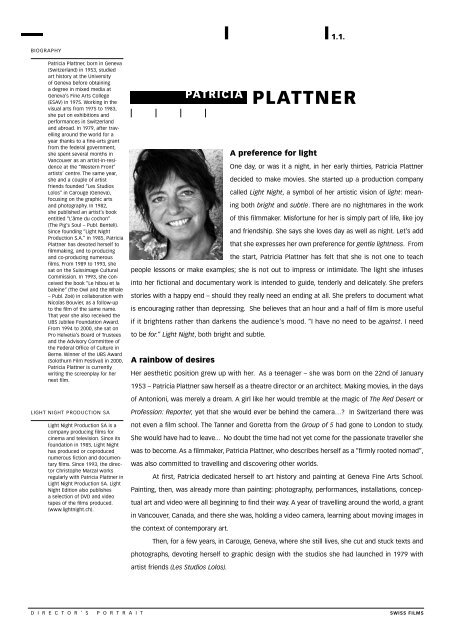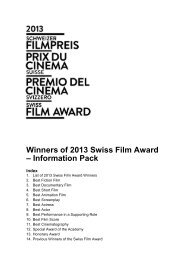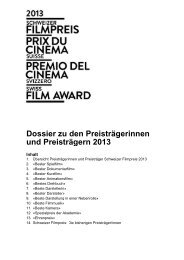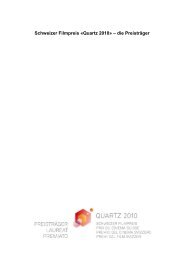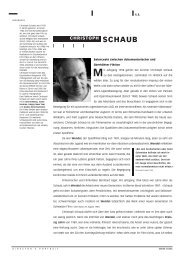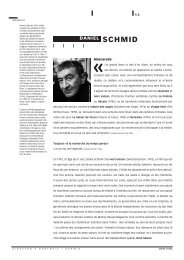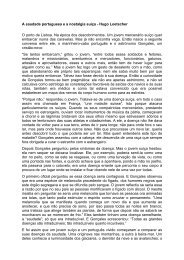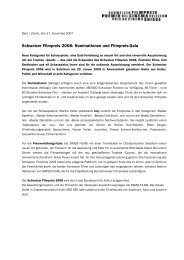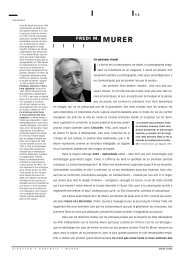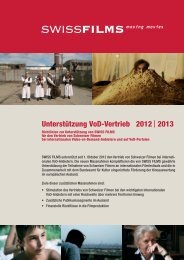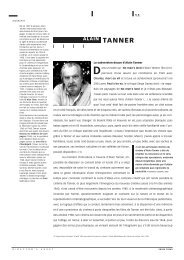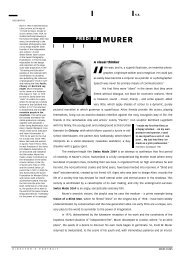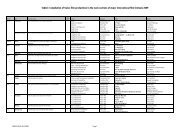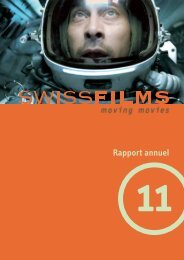Director's Portrait Patricia Plattner - Swiss Films
Director's Portrait Patricia Plattner - Swiss Films
Director's Portrait Patricia Plattner - Swiss Films
You also want an ePaper? Increase the reach of your titles
YUMPU automatically turns print PDFs into web optimized ePapers that Google loves.
BIOGRAPHY<br />
<strong>Patricia</strong> <strong>Plattner</strong>, born in Geneva<br />
(Switzerland) in 1953, studied<br />
art history at the University<br />
of Geneva before obtaining<br />
a degree in mixed media at<br />
Geneva’s Fine Arts College<br />
(ESAV) in 1975. Working in the<br />
visual arts from 1975 to 1983,<br />
she put on exhibitions and<br />
performances in Switzerland<br />
and abroad. In 1979, after travelling<br />
around the world for a<br />
year thanks to a fine-arts grant<br />
from the federal government,<br />
she spent several months in<br />
Vancouver as an artist-in-residence<br />
at the “Western Front”<br />
artists’ centre. The same year,<br />
she and a couple of artist<br />
friends founded “Les Studios<br />
Lolos” in Carouge (Geneva),<br />
focusing on the graphic arts<br />
and photography. In 1982,<br />
she published an artist’s book<br />
entitled “L’âme du cochon”<br />
(The Pig’s Soul – Publ. Benteli).<br />
Since founding “Light Night<br />
Production S.A.” in 1985, <strong>Patricia</strong><br />
<strong>Plattner</strong> has devoted herself to<br />
filmmaking, and to producing<br />
and co-producing numerous<br />
films. From 1989 to 1993, she<br />
sat on the Suissimage Cultural<br />
Commission. In 1993, she conceived<br />
the book “Le hibou et la<br />
baleine” (The Owl and the Whale<br />
– Publ. Zoé) in collaboration with<br />
Nicolas Bouvier, as a follow-up<br />
to the film of the same name.<br />
That year she also received the<br />
UBS Jubilee Foundation Award.<br />
From 1994 to 2000, she sat on<br />
Pro Helvetia’s Board of Trustees<br />
and the Advisory Committee of<br />
the Federal Office of Culture in<br />
Berne. Winner of the UBS Award<br />
(Solothurn Film Festival) in 2000,<br />
<strong>Patricia</strong> <strong>Plattner</strong> is currently<br />
writing the screenplay for her<br />
next film.<br />
LIGHT NIGHT PRODUCTION SA<br />
Light Night Production SA is a<br />
company producing films for<br />
cinema and television. Since its<br />
foundation in 1985, Light Night<br />
has produced or coproduced<br />
numerous fiction and documentary<br />
films. Since 1993, the director<br />
Christophe Marzal works<br />
regularly with <strong>Patricia</strong> <strong>Plattner</strong> in<br />
Light Night Production SA. Light<br />
Night Edition also publishes<br />
a selection of DVD and video<br />
tapes of the films produced.<br />
(www.lightnight.ch).<br />
D I R E C T O R ’ S P O R T R A I T<br />
PATRICIA PLATTNER<br />
A preference for light<br />
One day, or was it a night, in her early thirties, <strong>Patricia</strong> <strong>Plattner</strong><br />
decided to make movies. She started up a production company<br />
called Light Night, a symbol of her artistic vision of light: mean-<br />
ing both bright and subtle. There are no nightmares in the work<br />
of this filmmaker. Misfortune for her is simply part of life, like joy<br />
and friendship. She says she loves day as well as night. Let’s add<br />
that she expresses her own preference for gentle lightness. From<br />
the start, <strong>Patricia</strong> <strong>Plattner</strong> has felt that she is not one to teach<br />
people lessons or make examples; she is not out to impress or intimidate. The light she infuses<br />
into her fictional and documentary work is intended to guide, tenderly and delicately. She prefers<br />
stories with a happy end – should they really need an ending at all. She prefers to document what<br />
is encouraging rather than depressing. She believes that an hour and a half of film is more useful<br />
if it brightens rather than darkens the audience's mood. “I have no need to be against. I need<br />
to be for.” Light Night, both bright and subtle.<br />
A rainbow of desires<br />
Her aesthetic position grew up with her. As a teenager – she was born on the 22nd of January<br />
1953 – <strong>Patricia</strong> <strong>Plattner</strong> saw herself as a theatre director or an architect. Making movies, in the days<br />
of Antonioni, was merely a dream. A girl like her would tremble at the magic of The Red Desert or<br />
Profession: Reporter, yet that she would ever be behind the camera…? In Switzerland there was<br />
not even a film school. The Tanner and Goretta from the Group of 5 had gone to London to study.<br />
She would have had to leave... No doubt the time had not yet come for the passionate traveller she<br />
was to become. As a filmmaker, <strong>Patricia</strong> <strong>Plattner</strong>, who describes herself as a “firmly rooted nomad”,<br />
was also committed to travelling and discovering other worlds.<br />
At first, <strong>Patricia</strong> dedicated herself to art history and painting at Geneva Fine Arts School.<br />
Painting, then, was already more than painting: photography, performances, installations, concep-<br />
tual art and video were all beginning to find their way. A year of travelling around the world, a grant<br />
in Vancouver, Canada, and there she was, holding a video camera, learning about moving images in<br />
the context of contemporary art.<br />
Then, for a few years, in Carouge, Geneva, where she still lives, she cut and stuck texts and<br />
photographs, devoting herself to graphic design with the studios she had launched in 1979 with<br />
artist friends (Les Studios Lolos).<br />
1.1.<br />
SWISS FILMS
FILMOGRAPHY<br />
2005 Carnets de valse: Vienne-<br />
Paris-Lima (documentary)<br />
2004 Les dieux ne meurent jamais<br />
(film for tv)<br />
2002 Les petites couleurs (fiction)<br />
1999 Maestro, Maestro! Herbert<br />
von Karajan (film for tv)<br />
1998 Made in India (documentary)<br />
1997 Une histoire qui enjambe les<br />
alpes (film for tv)<br />
1996 Hôtel Abyssinie (documentary)<br />
1994 Le livre de cristal (fiction)<br />
1993 Le hibou et la baleine, Nicolas<br />
Bouvier (documentary)<br />
1991 Le sismographe, la lune et<br />
le léopard, David Streiff, 10<br />
ans de Locarno (1981–1991)<br />
(film for tv)<br />
1990 Des tableaux qui bougent,<br />
Georges Schwizgebel<br />
(film for tv)<br />
1989 Piano Panier ou la recherche<br />
de l'équateur (fiction)<br />
1986 La dame de pique (short film)<br />
BOOK<br />
1982 L'âme du cochon – Etat des<br />
lieux (éd. Benteli)<br />
D I R E C T O R ’ S P O R T R A I T<br />
> A preference for light<br />
PATRICIA<br />
Rhymes, pastels and sketches<br />
Her first experience of cinema was soon to come. A friend of hers was shooting a film and she was<br />
taken on as Jill of all trades: scenery, location and office work, production and catering. She got a<br />
glimpse of what filmmaking is about: professionalism, learning to cope, human and financial man-<br />
agement and, above all, if things go well, art too. Discovering that she had the makings of a director,<br />
she decided to make her own film. This was The Queen of Spades (1986), a short black-and-white<br />
film, a wink to Satyajit Ray’s Music Room, which brought her into the profession. “A promising sample<br />
of her qualities as a filmmaker”, commented one Geneva newspaper on seeing these twenty min-<br />
utes about the life of a Russian prince exiled on the banks of lake Léman, whose death turned the life<br />
of an unemployed man upside down. The wheel is turning.<br />
Three years passed until her first full-length film. An unexpected<br />
meeting with French-Portuguese producer Paulo Branco, a sym-<br />
bolic financial contribution to The Cannibals (Manoel de Oliveira,<br />
1988) and a collaboration was settled. Co-productions followed<br />
such as Abraham's Valley (Manoel de Oliveira, 1993), Modern Life (Laurence Ferreira Barbosa, 2000)<br />
or That Day (Raul Ruiz, 2003). And here she comes with Piano Panier or In Search of the Equator<br />
(1989): low budget, shot in Portugal, professional actors, a subtle, connivent cameraman, Matthias<br />
Kaelin, who was to remain her loyal accomplice; a talented editor, Loredana Cristelli and an emerging<br />
style: light, leisurely scenes in the lives of two young girls faced with love and uncertainty – with no<br />
moral ending. Life as it is, simple ordinary life, between bursts of emotion. Light, light, no burden!<br />
Light and music from real life<br />
<strong>Patricia</strong> <strong>Plattner</strong> is not trying to seduce or bamboozle anyone: presence and action are what mat-<br />
ters. This is the fantastic challenge on which she has founded her work. She has grasped the possi-<br />
bilities offered by cinema – narrative, image, sound, attentive listening, actors’ direction, editing – to<br />
stimulate whatever exists or whatever is created by an artist. Whether in documentary or fiction,<br />
her position is that of the author of a reality, both the one she encounters and the one she invents.<br />
As an author with a light touch, she won’t force her point.<br />
Amongst all the documentaries she has made, three masterful portraits illustrate her skills.<br />
With Nicolas Bouvier, (The Owl and the Whale, 1993), she remains at a distance behind the poet, a<br />
fragile man whom she allows to unveil himself through a long conversation, respecting his silences.<br />
They were close. From him, through her desire for restraint, she received this overwhelming story<br />
of a writer's torment as he seeks words to tell his truth.<br />
1.2.<br />
PLATTNER<br />
“A journey needs no symbols. It<br />
does not take long to prove that<br />
it is enough in itself. You believe<br />
that you are making a journey,<br />
but soon it is the journey that is<br />
making – or unmaking – you. ”<br />
Nicolas Bouvier<br />
SWISS FILMS
AWARDS<br />
2002 Les petites couleurs<br />
Nomination <strong>Swiss</strong> Film Prize<br />
2002 (best fiction film)<br />
1999 Made in India International<br />
Prize of the Independants,<br />
Médias Nord-Sud Film Festival,<br />
1999; Quality Award (<strong>Swiss</strong><br />
Federal Office of Culture, Bern),<br />
1999<br />
1996 Hôtel Abyssinie Quality Award<br />
(<strong>Swiss</strong> Federal Office of Culture,<br />
Bern), 1996<br />
1994 Le livre de cristal Jury Award,<br />
Minsk, Bielorussia; International<br />
competition (Locarno International<br />
Film Festival, 1994)<br />
1993 Le hibou et la baleine,<br />
Nicolas Bouvier Quality Award<br />
(<strong>Swiss</strong> Federal Office of Culture,<br />
Bern), 1993; Prize from the<br />
<strong>Swiss</strong> Society of Authors (SSA),<br />
1993; Quality Award (Canton<br />
of Geneva, Public Instruction<br />
Department), 1993<br />
1989 Piano Panier ou la recherche<br />
de l'équateur Prize Max Ophüls<br />
(award for the best young<br />
actress Anne Laure Luisoni),<br />
Saarbrücken 1989, Germany;<br />
Public Prize, Saarbrücken<br />
Film Festival 1989, Germany;<br />
Quality Award (<strong>Swiss</strong>, Federal<br />
Office of Culture, Bern), 1989;<br />
International competition<br />
(Locarno International Film<br />
Festival, 1989)<br />
1986 La dame de pique Study<br />
Award (<strong>Swiss</strong> Federal Office of<br />
Culture, Bern)<br />
D I R E C T O R ’ S P O R T R A I T<br />
> A preference for light<br />
With Herbert von Karajan, (Maestro, Maestro, 1999), she faces the opposite challenge: to set aside<br />
the noise that surrounds the director, to ignore his riotous celebrity and do justice to the power of<br />
the musician, the toil and vision of a man whose gift had been veiled by his reputation of wealth and<br />
fulfilment. He had died ten years before, so that archives and witnesses alone spoke for him. Some<br />
spoke well of him, and others did not. There were choices to be made. “I am here for the better”,<br />
says <strong>Patricia</strong> <strong>Plattner</strong>. Light takes precedence over darkness.<br />
With Made in India (1998), the filmmaker has chosen to shine her light on the Untouchables<br />
of India who have formed themselves into a trade union. This certainly was a political and moral<br />
choice, but it was also a characteristic one: Nicolas Bouvier was able to lighten his night through his<br />
words and images. So why should these women from India not lighten their own darkness by joining<br />
forces to demand dignity and fair treatment? It was a different situation, and a different method,<br />
but the same need to emerge from a tunnel.<br />
“Inconsolable, but joyful”, says <strong>Patricia</strong>, who always lives in hope, wherever her cinemato-<br />
graphic journeys around the planet take her.<br />
Red yellow and blue<br />
Fiction, like documentary, is all about tunes. The tune of the <strong>Swiss</strong> cinema during the sixties and<br />
seventies, as part of a political culture of opposition, was gradually altered during the following<br />
decades. While documentaries, including those by <strong>Patricia</strong> <strong>Plattner</strong>, continue in a <strong>Swiss</strong> tradition of<br />
expertise, relevance and originality, fictional films are isolated and disconnected. Each filmmaker<br />
has his own inspiration and takes his own chances.<br />
When she presented her second fictional film, Crystal Book, to compete at the Locarno<br />
Festival in 1994, <strong>Patricia</strong> <strong>Plattner</strong> faced some uncompromising criticism. She was accused of being<br />
ambitious. This was an international film, shot in Sri Lanka, with a script that was as a little <strong>Swiss</strong><br />
as it could possibly be. So it was judged according to the criteria of international cinema: glamour,<br />
surprise effects and effectiveness. Jean-François Balmer and Valeria Bruni-Tedeschi were not yet<br />
the celebrated actors they are today. It was a commercial failure. Not all the audiences got her<br />
point. Weaknesses were emphasised. There was no understanding of this war between Tamils and<br />
Sinhalese threaded in the story nor of the Buddha’s secret message recorded on transparent crystal<br />
plates. Nevertheless, the photography is splendid, the music inspired, and the commitment of her<br />
whole European and local crew overwhelming! Is the audience more demanding when it comes<br />
to fiction?<br />
PATRICIA<br />
1.3.<br />
PLATTNER<br />
SWISS FILMS
ABOUT THE AUTHOR<br />
Joëlle Kuntz writes editorials for<br />
the French language <strong>Swiss</strong> newspaper<br />
Le Temps and has written<br />
several works including Terminus,<br />
Réflexions sur les frontières<br />
d’un monde globalisé (Hachette-<br />
Littérature, 2004), L'histoire<br />
suisse en un clin d'œil (Zoé /Le<br />
Temps, 2006).<br />
D I R E C T O R ’ S P O R T R A I T<br />
> A preference for light<br />
<strong>Patricia</strong> <strong>Plattner</strong> went back to work, creating a documentary in Ethiopia and Eritrea, drawing from<br />
the shadows some of those old men, forgotten by history, washed up by the Italian colonial war<br />
(Hotel Abyssinia, 1996). This unexpected, glowing experience was an encouragement. More docu-<br />
mentaries followed.<br />
2002 was a turning-point: with her new fiction A Little Colour, she brought a beautiful sim-<br />
plicity to the theme of solidarity between two women (played by Anouk Grinberg and Bernadette<br />
Lafont). Although the subject of the film was quite profound, <strong>Patricia</strong> <strong>Plattner</strong> gave it a rather<br />
comical treatment, introducing a film within the film, The Ranch of Love, a soap opera: she alone<br />
believed in it at the time the script was written, joined by Jacques Robellaz, her constant musical<br />
companion. This time her film found an audience. It has something <strong>Swiss</strong> about it, a rhythm, a sense<br />
of workmanship, a firm root in the landscape (although it is a no man's land!). It was a successful<br />
film. With large audiences in Switzerland, France, Germany and even Japan, this film found its place<br />
in the box office and the festivals. It even made money. The challenge was met.<br />
A full rainbow<br />
After the tunnel of uncertainty, what remains is to continue, like her heroine, the hairdresser in<br />
A Little Colour. For ever “inconsolable but joyful”, <strong>Patricia</strong> <strong>Plattner</strong> repeats. “Cinema is the most<br />
beautiful job in the world. Each film is an adventure, a journey.”<br />
In her last documentary, Waltz Diaries: Vienna-Paris-Lima (2005), <strong>Patricia</strong> <strong>Plattner</strong> sheds<br />
light on the charm and turbulence of this overly sparkling music. Behind the waltz, in Vienna and in<br />
Paris, hearts meet or break. Behind the waltz, in Lima, there are stories of exile, cross-cultural mix<br />
and rebirth. The wheel keeps on turning.<br />
She is encouraged by the success of <strong>Swiss</strong> directors. “If anyone can reach an audience of a<br />
hundred thousand in this country, things may get moving again”. With a generous, sharing approach<br />
and a love of teamwork, she supports (mainly through her efforts as a producer) the work of the<br />
technicians and directors that surround her, such as Christophe Marzal, who works with her at<br />
Light Night.<br />
On a <strong>Swiss</strong> budget, however, it is difficult to make headway in the international landscape.<br />
She ends up complaining about this, gently, by the way. Though accepting to be a filmmaker in<br />
today’s Switzerland, she does not isolate herself but builds networks, crosses borders if necessary<br />
and moves forward. <strong>Patricia</strong> <strong>Plattner</strong>'s night is never completely dark, for the day will be bright, for<br />
sure. Joëlle Kuntz<br />
PATRICIA<br />
1.4.<br />
PLATTNER<br />
SWISS FILMS
Script: Sarah Gabay, Jean Bobby,<br />
<strong>Patricia</strong> <strong>Plattner</strong><br />
Cinematographer: Matthias Kaelin<br />
Sound: Henri Maikoff<br />
“I never see life in black. But this film<br />
is like a springtime within a springtime.”<br />
Anouk Grinberg, actress (Aujourd'hui<br />
le Parisien, May 25, 2002)<br />
“This creates a painful and enchanting<br />
dialectic between the longing<br />
for freedom and the wish for connectedness,<br />
between letting go and<br />
drawing close. The combination is<br />
so powerful and moving that the camera<br />
merely remains still and has no<br />
need to run after the characters. The<br />
audience follows them uninvited. In<br />
the end <strong>Patricia</strong> <strong>Plattner</strong> declares<br />
that great happiness is possible, and<br />
Christelle finds a fitting name for it:<br />
’Thank you’. [...]<br />
’A little colour’ has emancipated<br />
itself from aggressive feminism,<br />
and from the fear of kitsch as well.<br />
Nevertheless, this film does not offer<br />
shallow comfort, and you leave the<br />
cinema feeling that things may turn<br />
out well – and that you have not<br />
been deceived.” Caspar Wieck, Berliner<br />
Zeitung, 16 September, 2004<br />
“<strong>Patricia</strong> <strong>Plattner</strong>, Anouk Grinberg<br />
and Bernadette Lafont do not miss<br />
an opportunity and have conspired<br />
to create a rather indecent little film,<br />
open to rude humour and with an<br />
uncomfortable edge. The idea is ingenious:<br />
to bring together two poor<br />
girls who are addicted to a television<br />
series [...]. The very simple screenplay<br />
intelligently cultures and ultimately<br />
diverts the power of television productions,<br />
taking cliches and restoring<br />
them to powerful authenticity. Mona<br />
and Christelle make plans, dream of<br />
love and overcome their problems<br />
to achieve the promised happy ending.<br />
It would take very little for their<br />
belief, in the midst of this poverty, to<br />
tip over into open rebellion. Everything<br />
collapses when the two striking,<br />
brave and delightful actresses<br />
draw you, helpless into irresistible<br />
delight: this is truly funny.” L.B., Les<br />
Cahiers du cinéma, April 2002<br />
2002 35 mm<br />
A<br />
fter a terrible argument, Christelle, a hairdresser, flees her violent husband. She lands up in<br />
the Galaxy, a shabby old motel, frequented by long-distance drivers and sales representa-<br />
tives. Mona, the landlady, a pathetic and rather petulant widow, takes Christelle under her wing and<br />
helps her to find a taste for life again. They discover a shared passion for a televised soap opera:<br />
“The Ranch of Love”. Christelle has to face returning to her husband, but, thanks to Mona and her<br />
new environment, she becomes aware of her creative gifts. She also has encounters and discov-<br />
ers her own sensuality and desire and the love of Lucien, a young truck driver. Torn between her<br />
wish for independence and her desire for love, she becomes an itinerant hairdresser and roams the<br />
countryside until the day when Mona, Lucien and the last episode of her favourite soap open up<br />
new horizons for her.<br />
F I C T I O N F I L M S / P L A T T N E R<br />
Editing: Jeanetta Ionesco,<br />
Maya Schmid<br />
Cast: Anouk Grinberg, Bernadette<br />
Lafont, Philippe Bas, Gilles Tschudi,<br />
Jean-Pierre Gos<br />
Music: Jacques Robellaz<br />
Production: Light Night Production SA,<br />
Carouge<br />
Coproduction: Gemini <strong>Films</strong>, Paris;<br />
Télévision Suisse Romande (TSR),<br />
Genève; Canal +, Paris<br />
World Rights: Light Night Production,<br />
Carouge; Gemini <strong>Films</strong>, Paris<br />
Original Version: french (subtitles:<br />
english, german)<br />
DVD: http://www.lightnight.ch/2002_les-<br />
PetitesCouleurs.html<br />
A LITTLE COLOUR<br />
colour 96’ Les petites couleurs<br />
“[...] The two comic figures playing the leading roles shine with obvious enjoyment. Anouk Grinberg plays the vulnerability<br />
of her character exquisitely well and Bernadette Lafont, who is moving and funny by turns, breathes a communicative<br />
energy into the whole. As for the screenplay and the script, they always sound right and fit perfectly with this<br />
simple, magical story. Concentrated happiness!” T.B., Studio Magazine, April 2002<br />
SWISS FILMS
Script: <strong>Patricia</strong> <strong>Plattner</strong>, Seth Linder,<br />
Didier Haudepin, after the novel of<br />
Claude Delarue “L’herméneute ou le<br />
livre de cristal” (Editions de l’Aire, 1982)<br />
Cinematographer: Matthias Kaelin<br />
Sound: Daniel Ollivier<br />
Editing: Loredana Cristelli<br />
“[...] It is not the place that creates<br />
a sense of the exotic; it is the<br />
way in which you see it. With the<br />
exception of the opening scene,<br />
<strong>Patricia</strong> <strong>Plattner</strong> never pauses on a<br />
landscape, neither does she offer<br />
picturesque details of the customs<br />
and morals of the country. There is<br />
nothing spectacular about the choice<br />
of her images. <strong>Patricia</strong> <strong>Plattner</strong> is a<br />
hardened traveller. You can feel it in<br />
her film: her view is never comparative<br />
(’look how he eats, look how<br />
he dresses’); she identifies with the<br />
place. This filmmaker from Geneva<br />
does her work by hollowing out the<br />
strongest scenes: she barely shows<br />
the refugee camp at all, nor the war<br />
which is raging, and she is unmoved<br />
by the terrorist attack. ’Crystal book’<br />
is above all a film about an inner<br />
adventure. ’Whatever happens, nothing<br />
happens’, says one character.<br />
It is a difficult challenge to build a<br />
fiction on a phrase like that. The<br />
achievement of this film is that it<br />
has done this without becoming boring<br />
or annoying, or preaching at the<br />
audience.”<br />
Marie-Claude Martin, Le Nouveau Quotidien,<br />
11 August 1994<br />
Cast: Jean-François Balmer, Valeria<br />
Bruni-Tedeschi, Douglas Ranasinghe,<br />
Gamini Fonseka, John Arnold,<br />
Swarna Malawarachchi, S Madan,<br />
Jean-Pierre Sentier<br />
Music: Jacques Robellaz<br />
Production: Light Night Production<br />
SA, Carouge; Gemini <strong>Films</strong>, Paris;<br />
1994 35 mm colour 110’<br />
C<br />
alled by Unesco to decipher a sacred document that was recently discovered, famous orien-<br />
talist John Billetter has to overcome his own past to complete the task. It was precisely in Sri<br />
Lanka that his wife committed suicide. It is his own story that he deciphers in this book, and which<br />
leads him to encounter his own destiny. A film about memory. Personal memory: individuals' lives,<br />
with their past, their loves and achievements; and collective memory: culture, religion and ethnic<br />
belonging.<br />
F I C T I O N F I L M S / P L A T T N E R<br />
Madragoa Filmes, Lisboa<br />
Coproduction: Télévision Suisse<br />
Romande (TSR), Genève<br />
With the financial support of the Office<br />
Fédéral de la Culture (DFI), Berne;<br />
Ministère de la Culture et de la<br />
Francophonie (CNC), Paris; Instituto<br />
Portuges da Arte Cinematografica e<br />
CRYSTAL<br />
Audiovisual (IPACA), Lisboa; Ville de<br />
Genève, Eurimages<br />
World Rights: Gemini <strong>Films</strong>, Paris; Light<br />
Night Production SA, Carouge<br />
Original Version: french and english<br />
(subtitles: french, english, german)<br />
Le livre de cristal<br />
BOOK<br />
SWISS FILMS
Script: <strong>Patricia</strong> <strong>Plattner</strong><br />
Cinematographer: Matthias Kaelin<br />
Sound: Paulo de Jesus<br />
Editing: Loredana Cristelli<br />
“This story demands an intimate<br />
tone, and the greatest achievement<br />
of ’Piano Panier’ is that it has caught<br />
that tone and communicated it<br />
perfectly. <strong>Patricia</strong> <strong>Plattner</strong> reveals<br />
the tensions that arise between<br />
these two women with their different<br />
temperaments and contrasting<br />
social and cultural backgrounds with<br />
a precise, light and even humorous<br />
touch, as well as the moments of<br />
uninhibited intimacy...” Neue Zürcher<br />
Zeitung, August 1989<br />
Cast: Anne-Laure Luisoni, Rita Blanco,<br />
Diogo Doria, Daniel Wolf, Antoine<br />
Basler, Stefan Gusber, Paulo Branco<br />
Music: Jacques Robellaz<br />
IANO PANIER<br />
OR THE SEARCH OF THE EQUATOR<br />
1989 35 mm (blow up)<br />
A<br />
bitter-sweet sentimental comedy. The friendship between two young girls. Marie is <strong>Swiss</strong>,<br />
and Filipa is originally Portuguese. One of them is the eternal student, while the other is<br />
about to marry. After Marie is disappointed in love, Filipa suggests that they spend a month in Por-<br />
tugal with her family. Happiness, personal and cultural conflicts follow. There is joy, sadness, and a<br />
number of encounters. This is a period in their lives when they have to make choices. Sometimes<br />
they find it dizzying.<br />
F I C T I O N F I L M S / P L A T T N E R<br />
Production: Light Night Production,<br />
SA, Carouge<br />
Coproduction: Filmargem, Lisboa;<br />
Télévision Suisse Romande (TSR),<br />
Genève<br />
World Rights: Light Night Production<br />
SA, Carouge<br />
Original Version: french and portuguese<br />
(subtitles: english, german,<br />
spanish)<br />
colour 95’ Piano Panier ou la recherche de l'équateur<br />
SWISS FILMS
Script: <strong>Patricia</strong> <strong>Plattner</strong><br />
Cinematographer: Johannes Hammel,<br />
Dominique Delguste, Béatrice Mizrahi,<br />
Aldo Mugnier, Alejandro Legaspi<br />
“In these three capitals, which have<br />
all developed this three-beat rhythm<br />
in their own style, she finds people<br />
passionate enough to declare, with<br />
tears in their eyes: ’The waltz is the<br />
soul of my country’. Since she loves<br />
to dance, watch, listen and film while<br />
enjoying herself, <strong>Patricia</strong> <strong>Plattner</strong> has<br />
made an enchanting documentary,<br />
with a delicate touch and generous<br />
images and music.” Joëlle Kuntz,<br />
Le Temps, 27 December, 2005<br />
2005 video<br />
I<br />
Sound: Bruno Pisek, François Waledisch,<br />
Guillermo Palacios<br />
Editing: Loredana Cristeli<br />
Music: waltzes<br />
D O C U M E N T A R I E S / P L A T T N E R<br />
Production: Artline <strong>Films</strong>, Paris;<br />
Light Night Production, Carouge;<br />
Navigator Film, Wien<br />
Coproduction: Arte France, Issy-les-<br />
Moulineaux; Télévision Suisse<br />
Romande (TSR), Genève<br />
World Rights: Artline <strong>Films</strong>, Paris;<br />
Light Night Production, Carouge;<br />
Navigator Film, Wien<br />
Original Version: german/french/<br />
spanish (subtitles: french, german,<br />
english, spanish, italian)<br />
WALTZ DIARIES: VIENNA - PARIS -LIMA<br />
colour 55’ Carnets de valse: Vienne-Paris-Lima<br />
s the waltz revolutionary? Historically it was the first dance in which the couple were entwined,<br />
a man and a woman pressed together, turning to the rhythm of the music until they were dizzy<br />
and intoxicated. Whether a waltz is classical Viennese, Parisian musette or Peruvian with singing, it<br />
is part of the world's heritage. In Vienna, students are preparing for the opening of the Opera Ball.<br />
In Paris, enthusiasts visit dancing halls and open-air dance floors: “The musette? It is intravenous<br />
champagne!” In Lima, the waltz is a song of love to the sound of the guitar and the “cajon”.<br />
SWISS FILMS
Direction: Laurent Aubert, Ravi<br />
Gopalan Nair, <strong>Patricia</strong> <strong>Plattner</strong>,<br />
Johnathan Watts<br />
Cinematographer: Johnathan Watts<br />
Sound: Laurent Aubert, Johnathan<br />
Watts<br />
“I am one of those nomadic <strong>Swiss</strong><br />
who can also find happiness at<br />
home. What I like best is experiencing<br />
my home alongside the rest of<br />
the world.“ <strong>Patricia</strong> <strong>Plattner</strong>, Le Nouveau<br />
Quotidien, 5 April, 1994<br />
Editing: <strong>Patricia</strong> <strong>Plattner</strong><br />
Music: live<br />
Production: Musée d'Ethnographie<br />
de Genève (MEG), Genève<br />
Coproduction: Light Night Production,<br />
Carouge<br />
2004 video colour 52’<br />
D<br />
uring the dry season, certain villages in the district of Calicut in Southern India celebrate the<br />
Tirayâttam, or Dance of the Splendour. For several days, the villagers live to the rhythm of<br />
rites dedicated to their ancestors and to protective deities. These then make their appearance on<br />
earth, incarnated by dancers in flamboyant costumes and make-up. The Peruvannân, a family troop<br />
of former Untouchables, are responsible for organizing the celebrations. Between 1998 and 2003,<br />
Laurent Aubert, ethnomusicologist, and Johnathan Watts, photographer and video director, stayed<br />
several times in the region of Kerala. Accompanied by a specialist, they brought back on behalf of<br />
the Ethnographic Museum of Geneva more than 70 hours of rushes. These were <strong>Patricia</strong> <strong>Plattner</strong>,<br />
who restored all their meaning and significance by scrupulous editing. The aesthetic limitations<br />
observed in Gods never die are strict: no interviews, no voices off, simply a title card at the begin-<br />
ning and end of the film mention a few essential elements. Processions, sacrifices, sessions of pos-<br />
session, the camera plunges to the heart of the ceremonies and their preparations. Diametrically<br />
opposed to conventional didactics, this film offers us a total immersion in rich and complex festivi-<br />
ties. With its clearly established assumptions, it invites us to appreciate first and foremost the visual<br />
qualities of the spectacle and the force it radiates. A veritable explosion of colours and energy, each<br />
stage of the ritual is a moment of intense aesthetic pleasure. Geneviève Rossier (in catalogue of “Visions du réel”,<br />
International Film Festival, Nyon, 2004)<br />
D O C U M E N T A R I E S / P L A T T N E R<br />
World Rights: Light Night Production,<br />
Carouge; Musée d'Ethnographie de<br />
Genève (MEG), Genève<br />
Original Version: french and english<br />
DVD “Sketches of Kerala” (Gods never<br />
GODS<br />
die/The Time of the Puppets / The Three<br />
Wise Monkeys – orginal version: french/<br />
english / subtitles: english/french)<br />
http://www.lightnight.ch/2004_lesdieux.<br />
htm<br />
NEVER DIE<br />
Les dieux ne meurent jamais<br />
SWISS FILMS
Script: <strong>Patricia</strong> <strong>Plattner</strong><br />
Cinematographer: Séverine Barde<br />
Sound: Susanna Kumschick<br />
Editing: Maya Schmid<br />
Music: Indian music live<br />
“With assistance from her head<br />
camerawoman Séverine Barde, this<br />
filmmaker is devoted above all to<br />
restoring the reality of this experience<br />
of social change, through<br />
images and interviews, without<br />
being unaware of its limitations and<br />
difficulties. Thanks to the quality of<br />
the stories that she has gathered,<br />
her sense of looking and listening –<br />
indeed thanks to her feminine qualities<br />
– <strong>Patricia</strong> <strong>Plattner</strong> demonstrates<br />
above all how revolutionary this initiative<br />
is – and how it could serve as<br />
a model!” Frédéric Maire, L'Impartial,<br />
19 January 2000<br />
Production: Light Night Production,<br />
Carouge<br />
Coproduction: Télévision Suisse<br />
Romande (TSR), Genève<br />
1998 35 mm (blow up)<br />
M<br />
ade in India paints the portrait of SEWA, an association of self-employed female workers<br />
which comprises no less than 211'124 members in 1998. Based in the heart of India, at<br />
Ahmedabad, SEWA federates, organizes and educates women of the lowest castes, inspired by the<br />
political, economic and moralmodel advocated by Gandhi. To say that this is no small task, given<br />
Indian society’s apriorism, compartmentalization and economic difficulties, would be an under-<br />
statement. In order to illustrate what a daunting job it is, <strong>Patricia</strong> <strong>Plattner</strong> accompanies Martha,<br />
Ranbai, Geeta, Badrunnisha, Shakri and above all Rami on their daily rounds: with the support of<br />
the association, each plays her role in educating embroiderers, collecting and selling natural rub-<br />
ber, and carrying out the programmes of cleaning up urban areas and reforesting rural areas. It is<br />
seen how mentalities and activities are thus slowly but surely reformed. Others featured in the<br />
film are Ela R. Bhatt, the association’s founder, and Mirai Chattarjee, Reema Nanavaly and others<br />
in charge of running and developing the association’s bank, university, insurance and so on, struc-<br />
tures which play a vital part in its activity. The film also deals with the questions – or criticisms<br />
– aimed at the enterprise concerning the inclusion of women belonging to the upper classes, the<br />
admission of men, and so on. <strong>Patricia</strong> <strong>Plattner</strong> remains in the background and allows her superb<br />
images to tell the story of an unfolding new world. Bertrand Bacqué (in catalogue of "Visions du réel", International Film<br />
Festival, Nyon, 1998)<br />
D O C U M E N T A R I E S / P L A T T N E R<br />
World Rights: Light Night Production,<br />
Carouge<br />
Original Version: english, gujarati<br />
(subtitles english, french, german)<br />
DVD “Made in India”<br />
(orginal Version: english, gujarati,<br />
subtitles: french, german, english,<br />
spanish, spanish voice over)<br />
DVD: http://www.lightnight.ch/1999_<br />
madeInIndia.html<br />
MADE IN INDIA<br />
colour 91’ Made in India<br />
SWISS FILMS
Direction and script: <strong>Patricia</strong> <strong>Plattner</strong>,<br />
based on an idea of Fabienne<br />
Le Houerou<br />
Cinematographer: Daniel Cavillon<br />
“We are transported back to Dino<br />
Buzzatti’s The Desert of the Tartars<br />
– the same feeling of strangeness,<br />
of hypnotizing heat and of being<br />
fatally stranded in the sand. And<br />
too, the same waiting. Waiting for<br />
what? For death, no doubt. In Hotel<br />
Abyssinia, Geneva’s <strong>Patricia</strong> <strong>Plattner</strong><br />
describes a group of aged Italians so<br />
long lost to the world that the world<br />
has forgotten them. They explain,<br />
in their mother tongue, why they<br />
chose to remain in Ethiopia after<br />
1942 – after Mussolini’s defeat and<br />
the fall of the short-lived Empire of<br />
Italian East Africa. In Hotel Abyssinia<br />
the filmmaker unearths an unsung<br />
or totally unknown slice of post-war<br />
history. Why this voluntary exile? Out<br />
of love for Africa? To lead an easy<br />
life? To avoid facing the war damage<br />
to Italy? Or because they had nothing<br />
to loose? Testimony provided by<br />
several survivors in their eighties (in<br />
1936 they were barely twenty) alternates<br />
with a more physical and sensuous<br />
approach to a country that the<br />
filmmaker – despite her extensive<br />
travels – had not explored before<br />
working there. An enthralling film.”<br />
Marie-Claude Martin, Le Nouveau Quotidien,<br />
29 July 1996<br />
Sound: Michèle Cavillon<br />
Editing: Edwige Ochsenbein<br />
Music: italian and ethiopian music<br />
1996 35 mm (blow up)<br />
S<br />
D O C U M E N T A R I E S / P L A T T N E R<br />
Production: MC4 Production, Paris<br />
Coproduction: Light Night Production<br />
SA; la sept/arte France; Televisione<br />
Svizzera Italiana (TSI), Lugano<br />
colour 64’<br />
tarting from the work of Fabienne Le Houerou published under the title “Les Ensablés”,<br />
<strong>Patricia</strong> <strong>Plattner</strong> travelled to Ethiopia to meet the last surviving Italians sent to Abyssinia dur-<br />
ing the time of fascism and the Italian colonial war: these men and women had come from Italy at<br />
the age of 20, their heads filled with dreams, and remained there despite the defeat. Some of them<br />
found a freedom there which they had not known in Italy; others found work; others still found a<br />
woman... Through the stories of Amedeo, Cesar, Oreste, Alba, Gino and the others, the filmmaker<br />
today seeks to understand the reasons for this unexpected exile.<br />
World Rights: MC4 Production, Paris<br />
Original Version: french, italian<br />
HOTEL ABYSSINIA<br />
Hôtel Abyssinie<br />
SWISS FILMS
Script: <strong>Patricia</strong> <strong>Plattner</strong>,<br />
Nicolas Bouvier<br />
Cinematographer: Matthias Kaelin<br />
Sound: Jean Faravel<br />
“Dear Nicolas,<br />
Some pleasures come in stages, like<br />
space rockets. In this case, you were<br />
the first stage, and that was enough<br />
to point me towards the destination.<br />
The second was the voyage, Japan,<br />
the owl and the whale, in short<br />
everything that I love. The third, and<br />
the crowning glory of them all: the<br />
exceptional quality of the film, its<br />
elegance and poise, this way of melting<br />
away in the face of one's subject<br />
while affirming a style that should<br />
be the standard for television portraits<br />
(but is it perhaps in Switzerland?).<br />
In brief, this was a captivating<br />
moment, and I would like to ask you<br />
to pass this on to <strong>Patricia</strong> <strong>Plattner</strong>,<br />
whose name sounds like a Chandler<br />
heroine or a billionaire heiress from<br />
Boston.<br />
The owls and whales that surround<br />
me (and a few cats) all send you<br />
their love on this Autumn day.”<br />
Chris (letter sent by Chris Marker to Nicolas<br />
Bouvier on 28 August 1993)<br />
“This filmmaker has created a model<br />
documentary: her editing and sense<br />
of rhythm are perfect, her camera is<br />
always listening to Nicolas Bouvier<br />
but without becoming preachy or<br />
boring, and the selected sequences<br />
paint the picture of a man who is<br />
always fascinating.”<br />
Pascal Gavillet, La Tribune de Genève,<br />
2 March 1994<br />
Editing: Najet Ben Slimane<br />
Music: Claude Debussy, ethnic live<br />
music recorded by Nicolas Bouvier<br />
during his trips<br />
THE OWL AND THE WHALE NICOLAS<br />
BOUVIER<br />
1993 16 mm<br />
T<br />
D O C U M E N T A R I E S / P L A T T N E R<br />
Production: Light Night Production,<br />
Carouge<br />
Coproduction: PCT cinéma télévision<br />
sa, Martigny-Combe; Télévision Suisse<br />
Romande (TSR), Genève<br />
colour 57’<br />
World Rights: Light Night Production,<br />
Carouge<br />
Original Version: french (subtitles:<br />
english, german, spanish)<br />
DVD: http://www.lightnight.ch/1993_<br />
Lehibouetlabaleine.html<br />
Le hibou et la baleine, Nicolas Bouvier<br />
he great <strong>Swiss</strong> writer Nicolas Bouvier was as full of ideas as he was curious about the world<br />
– a consummate traveller whose slanting eyes bespoke endless readings of Buddhist monks.<br />
His stays in Asia and the West afford his descriptions a breadth and rhythm that sets them at a vast<br />
remove from those of the hurried globetrotter. This captivating figure of many talents and facets<br />
was a man of images. His taste for photography and libraries made an iconographer of him, as did,<br />
too, the need to make a living. In this film, Bouvier ponders seven of his preferred topics of reflec-<br />
tion of the moment, interspersed with a choice of emblematic images and favourite music pieces.<br />
SWISS FILMS
erbert von Karajan is without doubt the greatest conduc-<br />
tor of this century. But he is also one of the most secre-<br />
tive. Who is hiding behind the impressive figure of the maestro?<br />
How has he built up his musical empire? What were his work-<br />
ing methods? Did he really collaborate with the Nazi regime?<br />
Ten years after his death, this film creates a portrait without<br />
indulgence of a controversial man whose modernity continues<br />
to surprise us.<br />
MAESTRO, MAESTRO! HERBERT VON<br />
1999 video colour & b/w<br />
H<br />
“Maestro, Maestro! (that was what Ozawa decided to call his master) demonstrates<br />
the precision of its maker's eye and opens our eyes to a man who<br />
so often liked to close his own – whether he was facing his orchestra or<br />
certain aspects of his life.” Classica, September 1999<br />
1997 video colour 43’<br />
M<br />
ont-Blanc is surrounded by three valleys, in three differ-<br />
ent countries: Switzerland, Italy and France. This moun-<br />
tainous area shares a culture, a language and a love of cows,<br />
bells, cheese and smuggling. This report allows us to discover<br />
a number of different, colourful characters who share with us<br />
their sense of “Alpine belonging”.<br />
avid Streiff, director of the Locarno International Film<br />
Festival. For a decade David Streiff has demonstrated<br />
his talent for discovering films, looking for young filmmakers<br />
and new forms of cinematography. He has also set the Locarno<br />
Festival in a direction that would please both professionals<br />
and amateurs. To ensure that the moon looks favourably on<br />
the films at Locarno, the festival's director listens carefully and<br />
attentively throughout the year, recording like a seismograph.<br />
Who is this shadowy man and what is this work that he does,<br />
built on his love of cinema?<br />
Script: Claire Alby<br />
Cinematographer: Sven Kiesche<br />
Sound: Stephan Schaedlich, Thomas<br />
Gaede, Raffaele Ventura<br />
Editing: Loredana Cristelli<br />
Music: Mozart, Verdi, Beethoven, Brahms...<br />
With the participation of: Christa Ludwig,<br />
Seiji Osawa, Anne-Sophie Mutter<br />
A STORY CROSSING THE ALPS<br />
T E L E V I S I O N & S H O R T F I L M S / P L A T T N E R<br />
Script: <strong>Patricia</strong> <strong>Plattner</strong><br />
Cinematographer: Romed Wyder<br />
Sound: François-Christophe Marzal<br />
Editing: <strong>Patricia</strong> <strong>Plattner</strong>, François-<br />
Christophe Marzal<br />
Music: La Kinkerne, Schubert<br />
Script: <strong>Patricia</strong> <strong>Plattner</strong><br />
Cinematographer: Matthias Kaelin<br />
Sound: John Furrer<br />
Editing: Najet Ben Slimane, <strong>Patricia</strong><br />
<strong>Plattner</strong><br />
Production: Télévision Suisse Romande<br />
(TSR), Genève<br />
Production: MC4 Production, Paris<br />
Coproduction: Arte, France; Pro Vobis,<br />
Germany; Ina, Paris; Mezzo, Paris;<br />
Strada Productions, Greece, Light Night<br />
Production, Carouge<br />
World Rights: MC4 Production, Paris<br />
Original Version: german, french, english<br />
Production: Télévision Suisse Romande<br />
(TSR), Genève<br />
World Rights: Télévision Suisse<br />
Romande (TSR), Genève, magazine Viva<br />
Original Version: french, Alpine dialect<br />
THE SEISMOGRAPH, THE MOON & THE LEOPARD,<br />
1991 video colour 50’<br />
D<br />
85’ (55’ TV version)<br />
Une histoire qui enjambe les Alpes<br />
Le sismographe, la lune et le léopard,<br />
David Streiff, dix ans de Locarno (1981–1991)<br />
KARAJAN<br />
DAVID STREIFF,<br />
TEN YEARS OF LOCARNO (1981–1991)<br />
Coproduction: Televisione Svizzera<br />
Italiana (RTSI), Lugano; Schweizer<br />
Fernsehen (DRS), Zürich<br />
World Rights: Télévision Suisse<br />
Romande (TSR), Genève<br />
Original Version: french, german, italian<br />
(subtitles: french, german, italian)<br />
SWISS FILMS
MOVING PAINTINGS, GEORGES SCHWIZGEBEL<br />
1990 16 mm colour 43’ Des tableaux qui bougent, Georges<br />
Schwizgebel<br />
A<br />
nimator Georges Schwizgebel is not an unknown figure.<br />
His short films have travelled all around the world. These<br />
films, which are strongly inspired by music, draw us into a whirl<br />
of personal images, mostly painted or drawn. In this portrait,<br />
the audience has the opportunity to discover many excerpts<br />
from films by Georges Schwizgebel and to meet an appealing<br />
artist, as modest as he is gifted. Following a one-year stay in<br />
Shanghai, a city to which he has dedicated a film, he married<br />
Yaping with whom he has had two children, Louis and Tina.<br />
1986 16 mm b/w 22’<br />
O<br />
n the banks of Lake Léman, an old, exiled Russian prince<br />
spends an hour each day in memories and nostalgia.<br />
Now poor and alone, he even pays a companion to help with<br />
this ritual, so that he can perpetuate what used to be his world<br />
and avoid sinking into depression. To pay for this he gradually<br />
loses his family heirlooms to an obsequious antiques dealer,<br />
with a strong aesthetic sense and a keen sense of money.<br />
When the prince dies, the world is turned upside down, with<br />
an unexpected twist…<br />
La dame de pique<br />
“Genevese filmmaker <strong>Patricia</strong> <strong>Plattner</strong> has made a success of ’The Queen of<br />
Spades’, her first short film. Shot in black and white, it follows an old, exiled<br />
Russian prince on the banks of the Léman, and in about twenty minutes she<br />
offers a promising sample of her qualities as a filmmaker.” Françoise Deriaz, La<br />
Suisse, 30 January 1987<br />
T E L E V I S I O N & S H O R T F I L M S / P L A T T N E R<br />
Script: <strong>Patricia</strong> <strong>Plattner</strong><br />
Cinematographer: Roger Bovard<br />
Sound: François Barmaverain<br />
Editing: Najet Ben Slimane<br />
Production: Télévision Suisse Romande<br />
(TSR), Genève; magazine Viva, Genève<br />
THE QUEEN OF SPADES<br />
Script: <strong>Patricia</strong> <strong>Plattner</strong><br />
Cinematographer: Aldo Mugnier<br />
Sound: Pierre-Alain Besse<br />
Editing: Loredana Cristelli<br />
Cast: Boris I. Fedotov, François Berthet,<br />
Natalie Gerber, Pierre Michaëlis,<br />
André Martin<br />
Music: Jacques Robellaz<br />
Coproduction: Light Night Production,<br />
Carouge<br />
World Rights: Télévision Suisse<br />
Romande (TSR), Genève<br />
Original Version: french<br />
Production: Light Night Production SA,<br />
Carouge<br />
Coproduction: Télévision Suisse<br />
Romande (TSR), Genève; Ville de<br />
Genève<br />
World Rights: Light Night Production,<br />
Carouge<br />
Original Version: without dialogues<br />
SWISS FILMS


